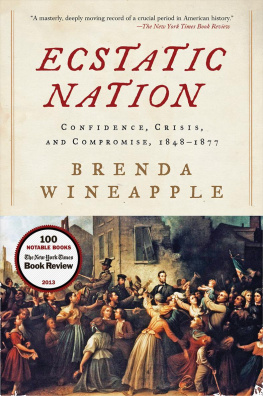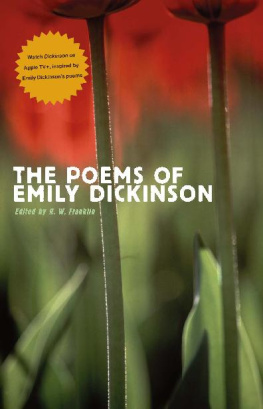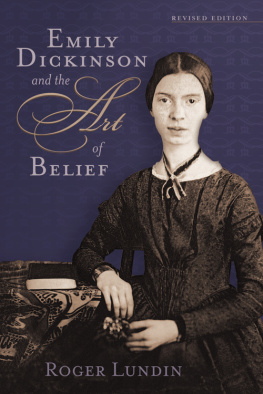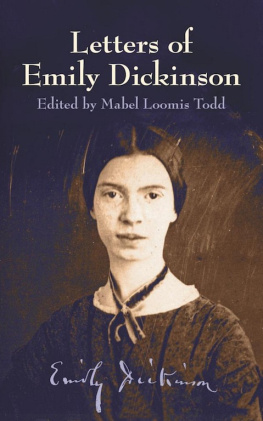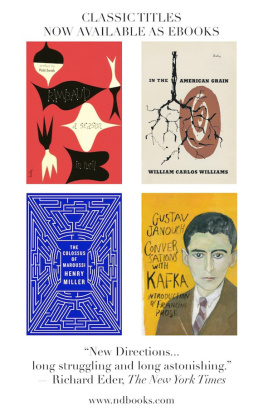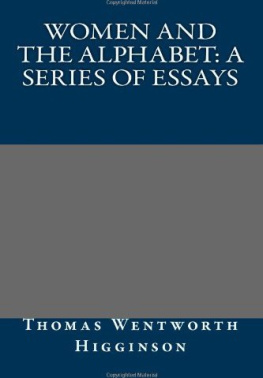Brenda Wineapple - White Heat: The Friendship of Emily Dickinson and Thomas Wentworth Higginson
Here you can read online Brenda Wineapple - White Heat: The Friendship of Emily Dickinson and Thomas Wentworth Higginson full text of the book (entire story) in english for free. Download pdf and epub, get meaning, cover and reviews about this ebook. year: 2008, publisher: Knopf, genre: Non-fiction. Description of the work, (preface) as well as reviews are available. Best literature library LitArk.com created for fans of good reading and offers a wide selection of genres:
Romance novel
Science fiction
Adventure
Detective
Science
History
Home and family
Prose
Art
Politics
Computer
Non-fiction
Religion
Business
Children
Humor
Choose a favorite category and find really read worthwhile books. Enjoy immersion in the world of imagination, feel the emotions of the characters or learn something new for yourself, make an fascinating discovery.

- Book:White Heat: The Friendship of Emily Dickinson and Thomas Wentworth Higginson
- Author:
- Publisher:Knopf
- Genre:
- Year:2008
- Rating:3 / 5
- Favourites:Add to favourites
- Your mark:
- 60
- 1
- 2
- 3
- 4
- 5
White Heat: The Friendship of Emily Dickinson and Thomas Wentworth Higginson: summary, description and annotation
We offer to read an annotation, description, summary or preface (depends on what the author of the book "White Heat: The Friendship of Emily Dickinson and Thomas Wentworth Higginson" wrote himself). If you haven't found the necessary information about the book — write in the comments, we will try to find it.
White Heat: The Friendship of Emily Dickinson and Thomas Wentworth Higginson — read online for free the complete book (whole text) full work
Below is the text of the book, divided by pages. System saving the place of the last page read, allows you to conveniently read the book "White Heat: The Friendship of Emily Dickinson and Thomas Wentworth Higginson" online for free, without having to search again every time where you left off. Put a bookmark, and you can go to the page where you finished reading at any time.
Font size:
Interval:
Bookmark:
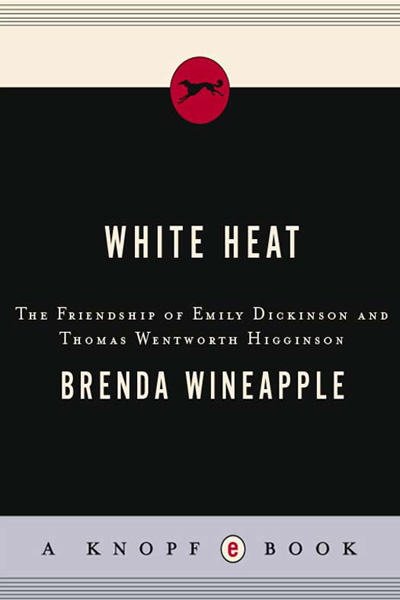
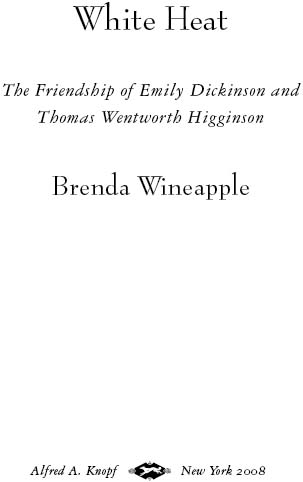
Contents
In memory of Sybille Bedford
Illustrations
Introduction
The Letter
ONE
The Letter
This is my letter to the World
That never wrote to Me
The simple News that Nature told
With tender Majesty
Her Message is committed
To Hands I cannot see
For love of HerSweetcountrymen
Judge tenderlyof Me
Reprinted by Thomas Wentworth Higginson and Mabel
Loomis Todd in Emily Dickinson, Poems (1890)
A re you too deeply occupied to say if my Verse is alive?
Thomas Wentworth Higginson opened the cream-colored envelope as he walked home from the post office, where he had stopped on the mild spring morning of April 17 after watching young women lift dumbbells at the local gymnasium. The year was 1862, a war was raging, and Higginson, at thirty-eight, was the local authority on physical fitness. This was one of his causes, as were womens health and education. His passion, though, was for abolition. But dubious about President Lincolns intentionsfighting to save the Union was not the same as fighting to abolish slaveryhe had not yet put on a blue uniform. Perhaps he should.
Yet he was also a literary man (great consolation for inaction) and frequently published in the cultural magazine of the moment, The Atlantic Monthly, where, along with gymnastics, womens rights, and slavery, his subjects were flowers and birds and the changing seasons.
Out fell a letter, scrawled in a looping, difficult hand, as well as four poems and another, smaller envelope. With difficulty he deciphered the scribble. Are you too deeply occupied to say if my Verse is alive?
This is the beginning of a most extraordinary correspondence, which lasts almost a quarter of a century, until Emily Dickinsons death in 1886, and during which time the poet sent Higginson almost one hundred poems, many of her best, their metrical forms jagged, their punctuation unpredictable, their images honed to a fine point, their meaning elliptical, heart-gripping, electric. The poems hit their mark. Poetry torn up by the roots, he later said, that took his breath away.
Today it may seem strange she would entrust them to the man now conventionally regarded as a hidebound reformer with a tin ear. But Dickinson had not picked Higginson at random. Suspecting he would be receptive, she also recognized a sensibility she could trustthat of a brave iconoclast conversant with botany, butterflies, and books and willing to risk everything for what he believed.
At first she knew him only by reputation. His name, opinions, and sheer moxie were the stuff of headlines for years, for as a voluble man of causes, he was on record as loathing capital punishment, child labor, and the unfair laws depriving women of civil rights. An ordained minister, he had officiated at Lucy Stones wedding, and after reading from a statement prepared by the bride and groom, he distributed it to fellow clergymen as a manual of marital parity.
Above all, he detested slavery. One of the most steadfast and famous abolitionists in New England, he was far more radical than William Lloyd Garrison, if, that is, radicalism is measured by a willingness to entertain violence for the social good. Inequality offended him personally; so did passive resistance. Braced by the righteousness of his causethe unequivocal emancipation of the slavesthis Massachusetts gentleman of the white and learned class had earned a reputation among his own as a lunatic. In 1854 he had battered down a courthouse door in Boston in an attempt to free the fugitive slave Anthony Burns. In 1856 he helped arm antislavery settlers in Kansas and, a loaded pistol in his belt, admitted almost sheepishly, I enjoy danger. Afterward he preached sedition while furnishing money and morale to John Brown.
All this had occurred by the time Dickinson asked him if he was too busy to read her poems, as if it were the most reasonable request in the world.
The Mind is so near itselfit cannot see, distinctlyand I have none to ask she politely lied. Her brother, Austin, and his wife, Susan, lived right next door, and with Sue she regularly shared much of her verse. Could I make you and Austinproudsometimea great way offtwould give me taller feet, she confided. Yet Dickinson now sought an adviser unconnected to family. Should you think it breathedand had you the leisure to tell me, she told Higginson, I should feel quick gratitude.
Should you think my poetry breathed; quick gratitude: if only he could write like this.
Dickinson had opened her request bluntly. Mr. Higginson, she scribbled at the top of the page. There was no other salutation. Nor did she provide a closing. Almost thirty years later Higginson still recalled that the most curious thing about the letter was the total absence of a signature. And he well remembered that smaller sealed envelope, in which she had penciled her name on a card. I enclose my nameasking you, if you pleaseSirto tell me what is true? That envelope, discrete and alluring, was a strategy, a plea, a gambit.
Higginson glanced over one of the four poems. Ill tell you how the Sun rose/ A Ribbon at a time. Who writes like this? And another: The nearest Dream recedesunrealized. The thrill of discovery still warm three decades later, he recollected that the impression of a wholly new and original poetic genius was as distinct on my mind at the first reading of these four poems as it is now, after thirty years of further knowledge; and with it came the problem never yet solved, what place ought to be assigned in literature to what is so remarkable, yet so elusive of criticism. This was not the benign public verse of, say, John Greenleaf Whittier. It did not share the metrical perfection of a Longfellow or the tiresome priapism (Emersons word, which Higginson liked to repeat) of Walt Whitman. It was unique, uncategorizable, itself.
The Springfield Republican, a staple in the Dickinson family, regularly praised Higginson for his Atlantic essays. I read your Chapters in the Atlantic Dickinson would tell him. Perhaps at Dickinsons behest, her sister-in-law had requested his daguerreotype from the Republicans editor, a family friend. As yet unbearded, his dark, thin hair falling to his ears, Higginson was nice looking; he dressed conventionally, and he had grit.
Dickinson mailed her letter to Worcester, Massachusetts, where he lived and whose environs he had lovingly described: its lily ponds edged in emerald and the shadows of trees falling blue on a winter afternoon. She paid attention.
He read another of the indelible poems she had enclosed.
Safe in their Alabaster Chambers
Untouched by Morning
And untouched by noon
Sleep the meek members of the Resurrection,
Rafter of Satin and Roof of Stone
Grand go the Years,
In the Crescent above them
Worlds scoop their Arcs
And Firmamentsrow
Diademsdrop
And Dogessurrender
Soundless as Dots,
On a Disc of Snow.
White alabaster chambers melt into snow, vanishing without sound: its an unnerving image in a poem skeptical about the resurrection it proposes. The rhymes drift and tilt; its meter echoes that of Protestant hymns but derails. Dashes everywhere; caesuras where you least expect them, undeniable melodic control, polysyllabics eerily shifting to monosyllabics. Poor Higginson. Yet he knew he was holding something amazing, dropped from the sky, and he answered her in a way that pleased her.
Next pageFont size:
Interval:
Bookmark:
Similar books «White Heat: The Friendship of Emily Dickinson and Thomas Wentworth Higginson»
Look at similar books to White Heat: The Friendship of Emily Dickinson and Thomas Wentworth Higginson. We have selected literature similar in name and meaning in the hope of providing readers with more options to find new, interesting, not yet read works.
Discussion, reviews of the book White Heat: The Friendship of Emily Dickinson and Thomas Wentworth Higginson and just readers' own opinions. Leave your comments, write what you think about the work, its meaning or the main characters. Specify what exactly you liked and what you didn't like, and why you think so.

